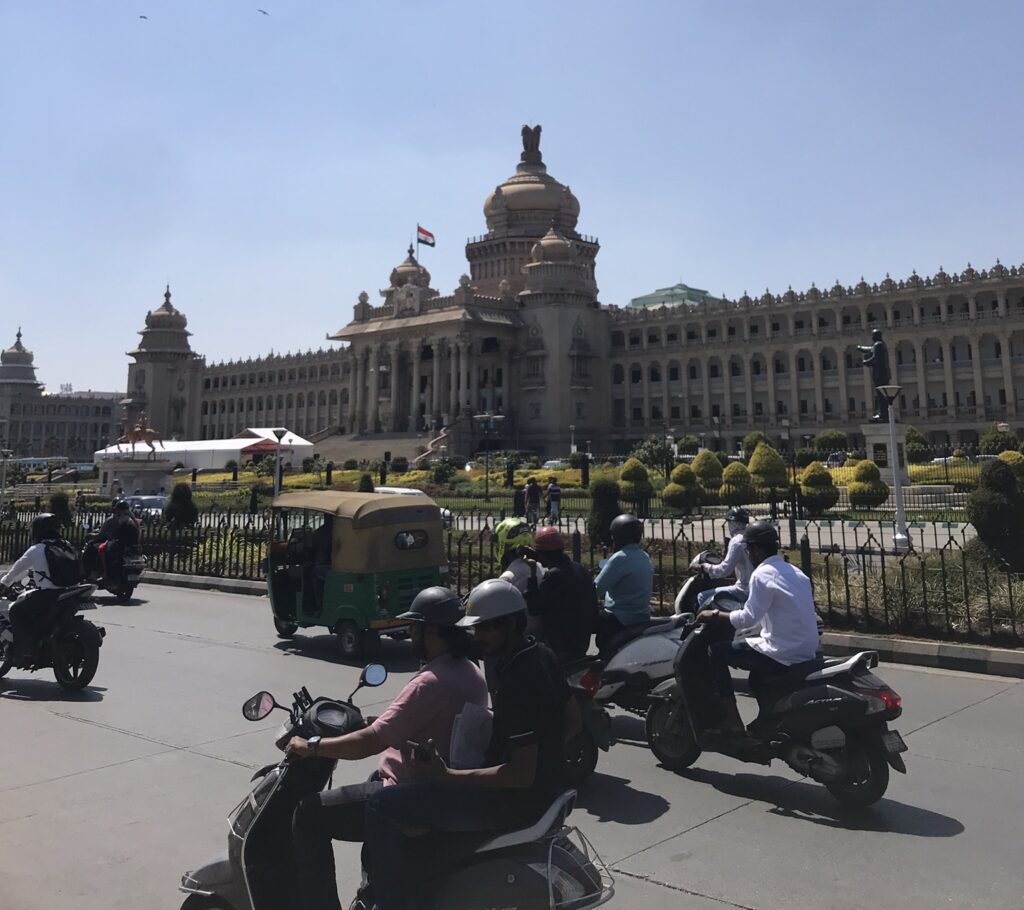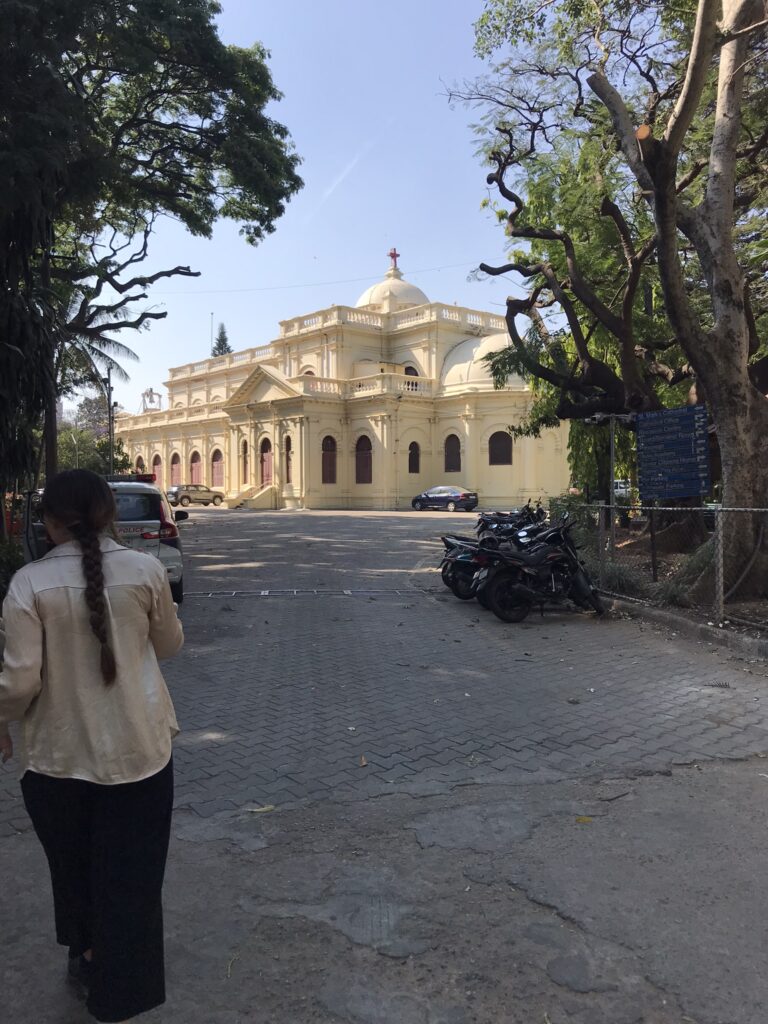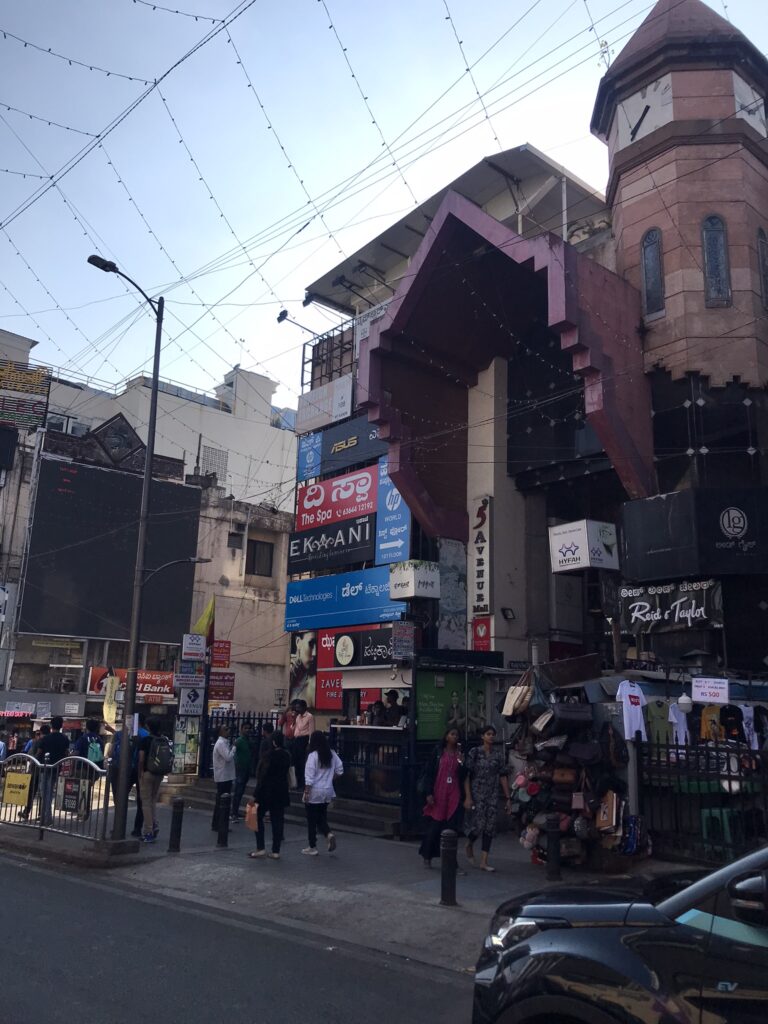Known today as a modern tech hub, Bengaluru is the capital of Karnataka state and one of the largest cities in India. Having once been a part of the Mysore kingdom under Hyder Ali and Tipu Sultan, it later became the regional capital when the British took control and moved administrative functions to the area in 1831. And the rest is history. Check out our tried-and-tested walking tour of the areas surrounding Cubbon Park!

Start at Vidhana Soudha. This enormous, grandiose building contains the Karnataka state legislature. The building was constructed post-independence, finished in 1956, and deliberately avoided the British colonial style that can be found in many other buildings in this area. Instead, it is constructed in a style reminiscent of south Indian temples. The slightly ominous phrase ‘Government Work is God’s Work’ appears very prominently on the front of the building.
This iconic structure was created with the intention of sending a symbolic message of prosperity and unity post-independence. However, ironically over the years it has been notoriously difficult/nigh-on impossible for members of the public to visit the inside of the Vidhana Soudha. In recent years the local authorities have eased their stance slightly, and guided tours of this large complex may now be taking place on specific dates. Next door, the sister building known as the Vikasa Soudha contains the state secretariat.
Opposite Vidhana Soudha is the Karnataka High Court building. This striking red building dates back to 1864, when it was built by the British as an administrative headquarters for the princely state of Mysore. The tale goes that the British were unhappy with the local dynastic ruler in Mysore following an uprising against him in 1830, so removed most aspects of the local administration from his sphere and moved them to Bangalore, initially in Tipu Sultan’s Palace and then later into this purpose-built structure.
This building went on to house the secretariat of Mysore State following India’s independence. Most of the administrative functions were transferred to the Vidhana Soudha following its completion, and today the building just houses the court.

The High Court building is not open to the pubic – you can actually get the best view from the other side, within Cubbon Park
Head southeast from the High Court building and you will enter Cubbon Park. This leafy park was created by British colonialists in 1870. It stands today as a verdant green area at the centre of the bustling city. The park contains several notable colonial-era buildings and monuments, including a bandstand and the State Central Library, which dates back to the early 20th century and is constructed with distinctive red bricks.
Cubbon Park also contains the State Archaeological Museum (also known as the Government Museum) which is one of the oldest museums in India, dating back to the late 1870s. Sadly the museum was under renovation at the time of our visit – the first time it was closed in 150 years. As well as the Government Museum, there are a couple of other modern museums located nearby along Kasturba Road, including the Museum of Art and Photography (MAP) which houses both contemporary and historical works.
Head northeast along Kasturba Road and then southeast along Lavelle Road and you will reach St Mark’s Cathedral. This church dates back to 1816, making it one of the oldest in the city. It was initially used as a garrison Protestant church for the colonial British forces. The church was created in a distinct style with several domes which were intended to resemble St Paul’s Cathedral in London. Without the same scale or grandeur, the domes give the church a strange, bulbous look.

It may not be St Paul’s, but it’s an important local landmark nonetheless which is also known for the grandiose church organ inside
From St Mark’s, head further east along Lavelle Road onto St Mark’s Road. Turn left and you’ll see the distinctive Tract and Book Society building, which now contains the Hard Rock Cafe. Originally a tea house for upper-class British colonialists called Blighty Tea Rooms, this building was later occupied by the Bible Society, an Christian organisation set up in order to print and distribute copies of the Bible in different languages. Since then it has changed hands several times – at one point it was a branch of HMV, before being taken over by the Hard Rock Cafe.
From the Hard Rock Cafe, head east to walk down Church Street & Brigade Road. These vibrant streets are considered to be the heart of Bengaluru’s shopping and nightlife district. Shops are tightly packed in, literally on top of each other at times. You can find many international and local brands with flagship stores here.

Shops upon shops on Brigade Road
Along Brigade Road, you’ll encounter the Bengaluru Opera House. The Opera House dates back to the British period, having been constructed in 1910. In recent years the archaic has been swapped for the modern as the Opera House is now operated by Samsung and functions as a giant showroom. Visitors are welcome to enter without buying anything in order to admire the faithfully-maintained interiors, which now happen to be filled with laptops, smartphones, digital displays and the latest tech gadgets. This is a quirky attraction which reflects both Bengaluru’s history and modern status as a tech hub.
Further along Brigade Road you’ll come to St Patrick’s Church. This neo-Gothic church dates back to 1841. One of the classic colonial churches in the city, this Catholic church was popular with the Irish contingent in the colonial British forces, hence the name. Today it is a striking landmark within the busy shopping district.
